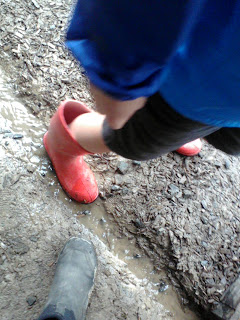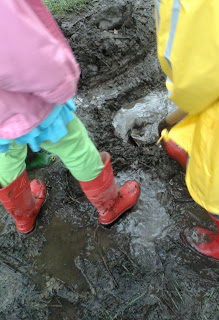Having recently attended a training in which she was convinced that kids have too much constraint in their lives (really?? these kids??), T persists in allowing the kids to choose their own activities (from a short list provided by her). This tactic creates a great deal of chaos at the start of class, but the end result, at least in theory, is that you get a group of kids who are really excited about whatever activity they are doing. Hmmm. The kids are jumping all around the garden trying to change groups, recruit their friends to their preferred activities, and generally postpone the start of class. And they are very loud. It makes me a little crazy.
This system of self-assignment frontloads the frustration factor. But then we all really do have fun, and the kids stay on task. I'm starting to buy in, and wondering how I could apply this principle to other aspects of my life. So when my youngest suggests that she should trade her current lightweight chore of feeding the cats in exchange for "washing the windows, scrubbing the walls, and sweeping," I, against my initial instinct, agree. You've never seen such energetic sweeping (even if you have seen a much cleaner floor). And the windows really are a little more transparent.
Back in garden class, my morning group made pumpkin muffins (recipe below) with great enthusiasm. And bringing things full circle, two afternoon kids chose to plant pumpkin seeds (check out the gorgeous heirloom pumpkin from which we saved aforementioned seeds last fall). So by the end of the day, we had proud cooks, full bellies, and several flats of pumpkin starts in the greenhouse. Seems that the system works after all. Trading a little crazy for a lot of good work. Not a bad plan for a garden, or a class or third graders, which really, if you think about it, needs both to thrive.
Pumpkin Muffins for the People (makes 30 good-size gluten-free muffins)
Beat 4 eggs.
Stir in 1 cup maple syrup and 4 tsp vanilla.
Then add:
5 cups Pamela's® gluten-free baking mix,
2 big scoops of cooked pumpkin (about 2 cups or more--ours was cooked in the fall and frozen until now),
and several shakes of whatever spices smell good to the kids (ours picked cardamom, cinnamon, cloves, and nutmeg).
Mix and transfer to well-greased muffin tins (fill each about 2/3 full).
Bake at 350º for 20 minutes or so.
In the afternoon, we made wheat flour muffins from a recipe we found lying around (which as usual we altered beyond recognition). They were lighter but not as sweet (since the morning group had used more than our share of the maple syrup, ooops), so the kids liked the gluten-free version better.













